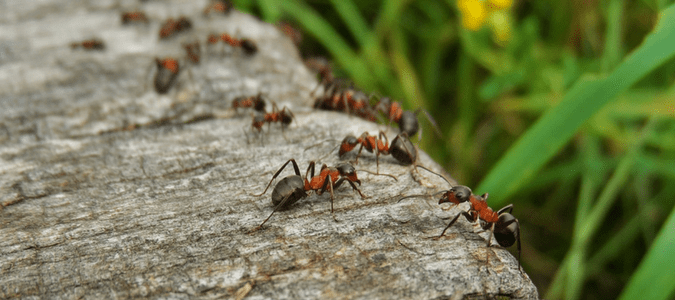
When you bought your new home, one of the first things that sold you on it was the large, gorgeously maintained yard. From being the greenest grass on the block to the colorful flowers and vibrant plants, it was like your own little oasis. Then something happened. Despite your best efforts, brown spots started appearing. Something was ravaging the leaves and flowers. You had been invaded. But by what? If you don’t know much about lawn pests, identification techniques or how much damage they can do, your beautiful lawn could be at risk.
You want to get rid of the pests and protect your lawn, but you’re not exactly sure what’s doing the damage. And you don’t want to get rid of helpful creatures along with the hurtful ones–not if you can avoid it.
Lawn Pests: Identification
So how do you identify which types of critters are harming your lawn? In this article, you’ll learn how to identify several different types of common lawn pests, how they hurt your lawn and what you can do to get rid of them.
How to determine what lawn pests you’re up against
There are numerous insects and other critters that tend to invade lawns in the south. Knowing what to look for is the first step in being able to deal with them.
Grubs
How do you know if you have grubs? As with many insect pests, the first thing you’re likely to notice is that parts of your lawn are turning brown and dying. You can tell if grubs are the culprit by trying to pick up one of these brown patches.
With grubs, the sod should pull up really easily–almost like you’re rolling up a carpet. This is because grubs are bugs that eat grass roots, so there’s nothing holding that patch of lawn down anymore, other than gravity.
In our experience, some of the best ways to send grubs packing include:
Chemical methods
Depending on your specific problem, curative or preventative chemicals may better suit your needs. Be wary, though. They can end up killing beneficial insects as well.
Don’t want to use chemicals? Other options include nematodes, milky spore or even drying them out by deciding to stop watering your lawn for a few weeks.
Chinch bugs
These little guys like to hide, but there’s a trick you can use to draw them out. Remove the bottom of a coffee can. Insert it into the earth near an area where you suspect chinch bugs. Add an inch or so of water. Wait.
In a few minutes, any chinch bugs there will float to the top of the water, and you’ll have your culprits. You can tell chinch bugs by their short (6mm) black bodies and white wings with black spots. Nymphs are smaller and red with a white band across their back.
Deal with a chinch bug problem using:
- Diatomaceous earth – It will tear their little bodies apart.
- Natural predators – Introduce insects such as lacewings and ladybugs to your yard and they’ll feed on the chinch bugs.
- Regular lawn maintenance – Taking good care of your lawn makes it less likely for chinch bugs to gain a foothold in the first place.
- Insecticides – Talk to an expert about what’s best to use.
Ants
You most likely already know many of the signs of ants. The most obvious one is their living space: the anthill. Simply put, if you see anthills outside, you have ants. The question then becomes: what kind of ants are hanging out in your yard?
One of the most common types of ants in the southeast U.S. is the fire ant. To the extent that you are able, you want to get these guys as far from your property as possible. You can recognize fire ants by their reddish-brown bodies and the painful sting they resort to if you disturb them.
Clear them out by using:
- Boiling water – If you pour two to three gallons of boiling water on a fire ant mound, it works to kill the colony about 60% of the time. However, this method is labor-intensive and can also kill surrounding grass and plants.
- Fire ant bait – The trick is to place bait around the mound rather than on top of it.
- Spray around the entire yard – The problem with focusing on individual mounds is that you’re essentially playing a game of whack-a-mole. You kill one mound and another appears. Then you take that one out but then the first mound reappears.
Experts who have debunked many home remedies agree: while it’s noble to want to minimize chemicals in your yard, sometimes they’re the best option you have.
Ticks
One of many grass bugs that bite, ticks are particularly scary due to the fact that they carry Lyme disease. Just as scary is the fact that your first indication that you have ticks on your property may be that you get bitten.
How do you identify a tick bite? This one’s easy, because the tick will most likely still be attached to you. All of that is the bad news. Here’s the good news: you can drastically decrease the possibility of ticks living in your yard by engaging in lawn maintenance tasks–some simple, some a bit more complex.
- Keep deer out – Deer can bring ticks with them. Because of this, you want to set up a barrier protecting your house and your yard. This may involve deer-resistant plants, deer repellants, and deer fencing.
- Prune, cut, and dry it out – Ticks thrive in wooded, humid conditions. If you keep your grass short, prune plants regularly and generally keep your yard dry, you’re in good shape.
If you decide to use chemicals to kill the ticks, there are a number of organic and non-organic options available.
Leave Lawn Care To the Pros
The trick in dealing with all these pests is finding a way to balance getting rid of the creatures you don’t want while keeping the ones you do want around. At ABC Home & Commercial Services, this “trick” is something we’ve been helping homeowners do for decades. Don’t just dive into pest removal on your own. Reach out to us and talk to our experts so we can help keep your yard healthy and pest-free.
